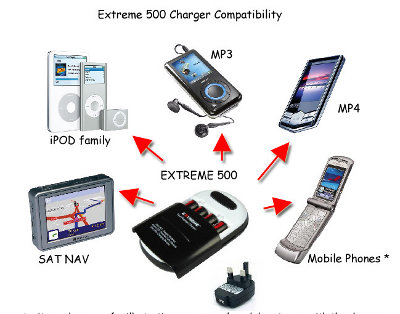 With more and more gadget you have, it is getting somewhat harder to keep them all charged while touring or on holiday. We have a camera, GPS, mobile phone, lights and sometimes a laptop that needs power, which means quite a few different chargers to drag along.
With more and more gadget you have, it is getting somewhat harder to keep them all charged while touring or on holiday. We have a camera, GPS, mobile phone, lights and sometimes a laptop that needs power, which means quite a few different chargers to drag along.
Depending on the gadget, how much you use it and with a little planing ahead, you can stretch the battery life out for a few days before you need a charge. This could even be extended with a little top up, which can be done while you are on the road. Look for a wall socket while you are having a break in a cafe, in a public toilet, on the train to the next destination. While visiting friends, on campsites and I have even see dedicated “charge points” in the airport.
But charging while riding your bicycle is a different kettle of fish. But like getting the power from the wall it makes life so much easier if you have few cables, chargers or gadgets that runs on the same kind of batteries. Which can been done with a little planing ahead and compromise on what the gadget needs to be able to do.
I got hold of another gadget to charge my gadgets, yeah I know, a Extreme 500 AA & AAA battery charger. This one can charge my AAA and AA batteries via USB, which you can charge from a computer or a wall socket. Best of all you can use it (the batteries you have charged) to charge other gadgets with it, if they can be charged by a USB cable, like my phone. And it is nice and compact so easy to carry around and pluck in to top up where ever you should find a wall plug.
I have looked into solar power and have yet found a solution that ticks all the boxes. The panels kinda needs to be rather big, facing the sun which is not always easy while cycling. To get the best charging with solar, it is best if you are in one place and able to turn the panels so that the sun is hitting them directly all the time. Along with the power pack (battery) solar power on the move becomes rather big/heavy. And at the moment solar power is also rather expensive. Though I’m looking forward to be proved wrong and have seen people managing their power needs with solar.
This is where my good friend in Denmark comes in, thanks mate. Since I have a dyno hub and I was wondering how to harness the power that I’m generating all the time but not always using it. I have happily forgotten which end of a soldering icon to hold 🙂 Or rather forgotten how to get turn the 6V 3W the dyno hub generates into 5V that a USB port puts out.
With a little search on the big www you should be able to find a “how to guide” or have a friend like mine who is smart enough to knock something up. So my friend knocked up something that when plugged into the dyno hub puts out 5V which is just what my phone and the USB battery charger need.
Here are some links that I found, Link 1, Link 2, Link 3, Link 4.
I think that about 30 minutes riding gives me around 10% charged on my phone, so with a full days cycling I can fully charge my phone. I haven’t tried yet to fully charge four AA’s with it yet, but I have seen that it does charge and there is more “juice” in them.
The reason for carrying the laptop is to entertained us while on the road, keep in touch and back up our photos. If it could be charge that with solar or dyno that would great, though most times when I use the laptop I’m near a power source.
The camera is there to take document and record our trips. Which is more important to have charged than the laptop. Some cameras do run on AA’s or maybe can be charged via USB so that can be charged but the dyno hub USB combo.
The GPS is mainly there as a toy and secondly to record where we have been but also to tell us where to go. Since it is running on AA’s the dyno hub USB charger combo takes care of that.
The mobile phone is there to be able to called for help if needed and send the odd text home saying hello. So only turned on once every couple of days which made the battery last longer. The phone is charged via a USB cable so not that heavy or big. If they did standardise even more I could be able to charge my mp3 player with the same USB cable. So the dyno hub USB combo charger will charge these two just fine.
The Hope One front light, head touches and rear lights runs either AA or AAA, which also can charge with the dyno hub USB charger combo.
That said on our tour of Australia and New Zealand, I think the longest we were off the grid was three or four days. In Australia even less since we stayed at friends. In New Zealand we could always find a plug to top up if needed. And if I had more than four AA’s and a spare battery for the camera we could have lasted few more days no problems.

Excellent! A bit of clicking around lead me to the Extreme 600 charger, which has 4 independent channels (so can charge odd numbers of cells – cheapo MP3 players and Petzl head torches have a lot to answer for!) and will run off a 5V supply at sane currents. That’s pretty much the holy grail for me charger-wise, as everything else I’ve found either wants oodles of current at 12V (which isn’t feasible with dynamo/solar power) or only charges pairs of cells in series to keep the efficiency up.
I was seriously considering designing my own charger to do pairs of AAs and pairs/threes of AAAs from dynamo/solar power, but however I approached it would rapidly deteriorate into nasty inductors and awkward physical design of the battery holders. This is much better.
Fab! I’ve just had a look at the extreme 500 also, it looks really good. Do you think it would cope with an iPod though? I usually have with me, a phone, a camera and the iPod, I’m on the look out for something to use when I go travelling next year, I know its 18 months away yet but I’m just looking for ideas!
Fully charged it managed to charge my HTC Nexus One 1.5 times. So I shouldn’t think an iPod would be a problem
Here is how I manage to charge all my 5V electronics and my power hungry laptop as well. I am cycling off the beaten track in Asia so I need to stay completely power indenpend and that means charging my Sony Vaio laptop (Z-Series) while cycling. My laptop battery has a charge content of 8Ah and takes max charging voltage of 12V at max current of 2A. There are three methods that I have tried very successfuly.
1) I instaled four Tung-Lin bicycle dynamos on my bike (two on each wheel). Connnected them in parallel to up the Amp. The Tung-Lin generator is the only bike generator I have found that have the right voltage and Amp for this purpose. It is rated at 12V and 0.5 Amp, so in theory, with four in parallel you get 12V and 2 Amp.
However in practice, you get about 12V and 1 Amp pedaling at about 15km/hr. This is because it is hard to pedal fast enough to generate 24Watts of power. With this method I can fully charge my laptop battery
in 7 to 8 hours.
Here is the link to the Tung-Lin dynamo at Amazon:
http://www.amazon.com/gp/product/B000OBWMGK/ref=oh_details_o02_s00_i00
2) This method is a solar method. Here I used the Brunton 26 Watt Foldable Solar Array. I also used a stand-alone laptop battery charger. Also I wanted to charge my battery while cycling so I constructed a “Top” for my bike out of stainless steel rods but you may or may not need this. The “top” can be disasembled into 16 stainless steel rods and be put away along with the Foldable solar array when not used. This method can
also charge my laptop battery in about 7 to 8 hours
Here is thelink to the Brunton Array:
http://www.amazon.com/gp/product/B000GEFFBO/ref=oh_details_o09_s00_i00
3) This idea is just like number 1) but use one dynamo instead. But you have to build this dynamo. I used the “Hacker A50-16L Brushless Outrunner RC Motor”. This is a motor used by toy hobyist to make
toy vehicles. This method is very complicated and you may not want to do this. But basicaly I had to use a gear coupled to the motor to step up the rotation of the bike wheel. Then I have to build my own
friction wheel with the right diameter to output 2A at 10km/hr biking speed. Also I fabricated a water tight
aluminum housing for the motor and two aluminum supports to support the whole contrabtion at the front
wheel. I used two springs placed inside the two supports to make the friction wheel pressed to the front
wheel. This took a long time to build and in the end it worked very well. With this method, I can charge
my laptop battery in about 4 hours. This is the same rate that it would take if I plug the stand alone charger into the wall outlet. However the down side is it is very heavy to pedal so I can only go at about 7km/hr.
For this reason, I later adjusted the diameter of the friction wheel so that I can bike at 10km/hr. This made the pedaling not as heavy but it reduced the output power and take longer to charge my battery.
So in the end the charging rate is the same as that of method 1). Thus the lesson is: The charging rate depend more on the indiviual pedaling abillity than the dynamo. In other word, how much power can your
body generate? and how long can you mantain it will determine how fast you can charge your battery.
Here is the link to the Hacker motor:
http://www.amazon.com/gp/product/B000U7ZW2E/ref=oh_details_o00_s00_i00
Note: you also need a 3-phases voltage rectifier to convert output of the motor to DC
In summery I found method 1) and 2) very effective. I used both. When it is sunny, I used solar and at night or in the cloudy rainy wheather, the four dynamo are very effective.
Method 1) is much cheaper than method 2)
Thanks for this, I will investigate. The only two things that I can’t power by my bicycle is the laptop and the batteries for my dSLR. By the look of this I think I can.